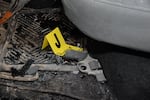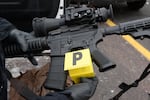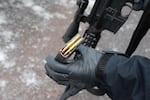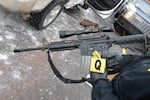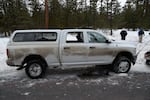An FBI agent who allegedly lied to investigators about a fatal shooting during the Malheur National Wildlife Refuge occupation has been identified.
W. Joseph Astarita appeared in federal court in Portland before federal Magistrate Judge Janice Stewart on Wednesday.
He's accused of lying to investigators about his role in the shooting death of Arizona rancher Robert "LaVoy" Finicum.
Astarita was a member of the FBI's hostage response team. He faces three counts of making false statements to federal and state investigators, and two counts of obstruction of justice, according to court documents unsealed Wednesday.
Through his attorney, Astarita pleaded not guilty to those charges, and requested a trial by jury. Stewart scheduled a one-week trial to begin Aug. 29 in front of U.S. District Court Judge Robert Jones.
Related: For Finicum Supporters, FBI Indictment Only A Partial Win
Astarita did not speak in court Wednesday, and is currently on pre-trial release. The false statement charges carry a maximum sentence of five years in prison. The obstruction charges carry a 20-year maximum.
Deschutes County Sheriff Shane Nelson said during a press conference that Astarita was not placed on administrative leave, and the investigation into FBI actions is ongoing.
Nelson also said he flew to Washington D.C. more than a year ago to meet with now-acting FBI Director Andrew McCabe and other Department of Justice officials.
"We informed them we found possible criminal conduct by some involved FBI (hostage rescue team) agents," Nelson said.
Finicum was a leader of the armed occupation of the Malheur refuge. He was shot and killed by an Oregon State Police trooper during a confrontation with law enforcement as occupiers traveled between Burns and John Day on Jan. 26, 2016.
During that confrontation, Astarita fired his weapon at Finicum as the rancher exited his vehicle. Though the two shots did not hit Finicum, the FBI agent did not immediately disclose those shots to the investigators, according to court documents.
"Specifically defendant W. Joseph Astarita falsely stated he had not fired his weapon during the attempted arrest of Robert LaVoy Finicum, when he knew then and there that he had," Assistant U.S. Attorney Pamala Holsinger wrote in the indictment.
News of the indictment quickly spread after the Oregonian broke the story late Tuesday, citing an anonymous source with knowledge of the case.
The charging document also states that Astarita knew his false statements could influence the "FBI's decision not to call the Shooting Incident Response Team to investigate the propriety of an agent-involved shooting."

The weapon found in militant leader Robert "LaVoy" Finicum's jacket pocket. The Central Oregon Major Incident Team released photos of evidence from Finicum's Jan. 26 shooting.
Central Oregon Major Incident Team
Prosecutors also said Astarita told lies around Feb. 6 to investigators with the intent to delay information traveling from the Oregon State Police to the FBI.
The federal Office of the Inspector General has been reviewing the shooting since Oregon investigators revealed their suspicions of a possible cover up in March 2016.
“A lot of people thought that investigation would linger forever, and nothing would ever come of it. For it to actually come around and result in an indictment, I think that’s a significant development,” said Todd Macfarlane, an attorney and political activist who has represented ranchers in Arizona and Utah in grazing conflicts with the Bureau of Land Management.
"I would hope that all of this would spur further investigation, and maybe an independent investigation," she said. "I'm hopeful that more truth will come out. It does raise doubt that there is more to be found."
Finicum’s death happened after the Malheur occupation had dragged on for 24 days with little end in sight, and the FBI had increased its presence in the nearby town of Burns, Oregon.
On Jan. 26, agents thought they had found an opportunity to bring the occupation to a close.
Finicum and other occupation leaders, including chief organizers Ammon and Ryan Bundy, were planning to travel from Burns to Grant County along a remote stretch of Highway 395.
Oregon State Police and the FBI set up a roadblock along that road.
Mark McConnell, who was driving Ammon Bundy's vehicle to the meeting, tipped off law enforcement to the John Day trip.
Related: LaVoy Finicum's Widow Plans To Sue Law Enforcement
During the traffic stop, Bundy exited the Jeep, lay down on the icy pavement and was arrested. Finicum, who was in a separate truck ahead of Bundy, initially stopped too. But minutes later, Finicum gunned the engine of his white pickup and took off down the twisting, tree-lined highway.
Finicum eventually crashed the pickup into a snowbank as law enforcement vehicles blocked the road. He jumped out from behind the wheel and repeatedly shouted at law enforcement to shoot him.
Aerial video taken by the FBI showed Finicum reaching twice toward his pocket, which police later said contained a loaded 9 mm semi-automatic handgun. Oregon State Police troopers shot and killed Finicum at that point.
On March 8, 2016, investigators ruled the troopers' use of force was justified. But they also announced a new federal investigation into members the FBI's elite Hostage Rescue Team who were at the scene.
OSP troopers and FBI HRT agents fired a total of eight shots. Two of the shots that came from FBI agents were not disclosed, investigators said.
And it’s the failure to disclose those shots that led to Astarita’s indictment.
McFarlane, the attorney who has represented Western ranchers in cases against the federal government, said many people sympathetic to Finicum’s cause believe law enforcement agents deliberately escalated the situation at the traffic stop that led to Finicum’s death.
“The indictment of one FBI agent will not necessarily answer all the unanswered questions people have,” he said.
OPB reports Amanda Peacher and Amelia Templeton contributed to this report.





